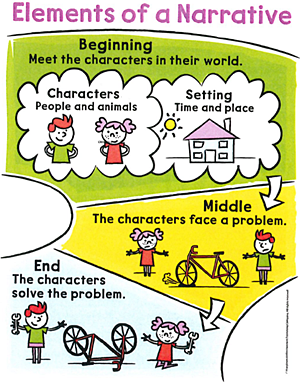Essay: Prewriting Steps (Part 2)
Essay: Prewriting Steps (Part 2)

Note: These are non-graded learning activities, so please do not submit them to the teacher.
In this Module, you will write a personal narrative, which is one type of narrative. On Day 3, we will begin to draft the narrative.
For today’s activities, you will need to download and print the Prewriting Steps (Part 2) handouts.
Part 1: Elements of a Narrative
Let’s review the elements of a narrative. Be sure you have included the following terms in your Writer’s Notebook.
- The narrator is the person telling the story.
- The setting is where the story takes place.
- The conflict is a problem in the story.
- The resolution is how the problem is solved.
To organize the structure of the narrative, it’s important to have a beginning, middle, and end.
- Beginning: What do you want the reader to know about you?
- Middle: Add specific and relevant details. Who did you help? How did you help? Where did you help? Why did you help?
- End: How did your action make the world a better place?
Now we will reread the model story A Good Deed on a Snowy Day
to identify the elements of a narrative. As you read, ask yourself the following question:
- How do you know this is a personal narrative? (I know this is a personal narrative because the story is about the person telling the story and the story uses the pronoun I.)
| Beginning | Middle | End |
|---|---|---|
| Who are the main characters? (Caden and I.) What is the setting? (A snow day at home.) What is the conflict? (Dad must go to work on a snow day.) |
What do Caden and the narrator do first? (They play in the snow; They have fun.) What do they notice as they play? (Their neighbors are coming home tired.) What do they decide to do to help? (Shovel for their dad and a neighbor.) |
How do you know their action helps? (Their dad is happy.) How do Caden and the narrator help make the world a better place (resolution)? (They help their dad and a neighbor.) |
Use the “Organize Your Personal Narrative” worksheet to help you begin organizing the personal narrative. You will use this worksheet to help you write the personal narrative rough draft.
Part 2: Set Goals for Writing
Next, you will create your goals for writing your personal narrative. You can use your past writing and reading for help when creating new writing goals.
Use the “Set Goals for Writing” worksheet to help create your goals. For example, when I read a story, I like when the author has a surprise ending. I also like when the author gives lots of details about the characters. I can turn these likes into my own writing goals.
Texas Tech K-12
-
Address
Texas Tech Plaza | 1901 University Ave, Lubbock, TX 79401 -
Phone
(800) 692-6877 -
Email
ttuk12@ttu.edu

